Metal chasing tools are specialized instruments you’ll use to compress and shape jewelry from the front surface, creating intricate textures and patterns without altering metal thickness. You’ll need essential punches like liner, rounded, and flat-faced varieties, plus a chasing hammer with a curved handle for precise control. These tools work with pitch that holds your metal securely while absorbing impacts during the shaping process. Master these fundamentals to reveal advanced dimensional techniques.
Understanding Chasing and Repoussé Techniques
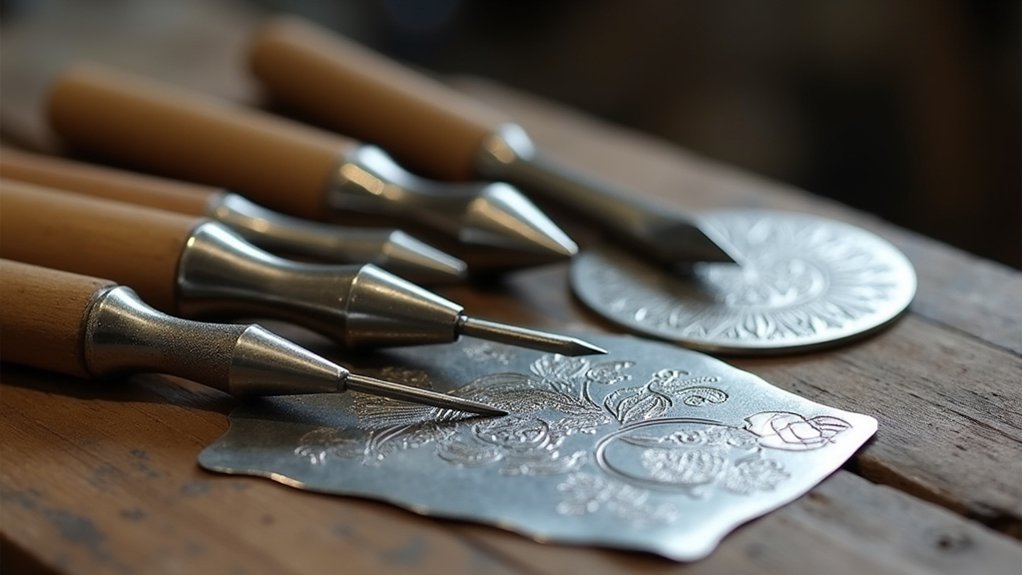
Mastery of chasing and repoussé transforms flat metal sheets into dimensional artworks through two complementary yet distinct approaches.
When you’re chasing, you’ll compress metal using specialized chasing tools to create detailed designs from the front surface. This technique allows you to add intricate textures and patterns without greatly altering the metal’s thickness.
In contrast, repoussé involves working from the reverse side, stretching metal to form raised patterns that emerge on the front surface. You won’t leave visible tool marks with this method.
You’ll often combine both techniques for maximum visual impact. The interplay between compressed and raised areas creates extraordinary depth and texture in your jewelry pieces, transforming simple metal sheets into sophisticated dimensional works that captivate viewers.
Essential Tools and Equipment for Metal Chasing
Before you can create stunning chased jewelry pieces, you’ll need to assemble an extensive toolkit designed specifically for metalworking. Your chasing hammer, featuring its distinctive curved handle, provides precise control when striking punches against metal surfaces. This specialized hammer works alongside various chasing punches that compress and shape your jewelry designs.
Essential chasing tools include:
- Liner punches – Create fine lines and detailed outlines in your metal work
- Rounded punches – Form smooth curves and organic flowing shapes
- Flat-faced punches – Produce clean, even surfaces and geometric patterns
- Doming punches – Shape dimensional elements and raised details
You’ll also need pitch to securely hold your metal sheets during work, absorbing hammer impacts effectively.
Don’t forget safety equipment like protective goggles and aprons to shield yourself from flying metal particles.
Safety Considerations and Proper Workspace Setup
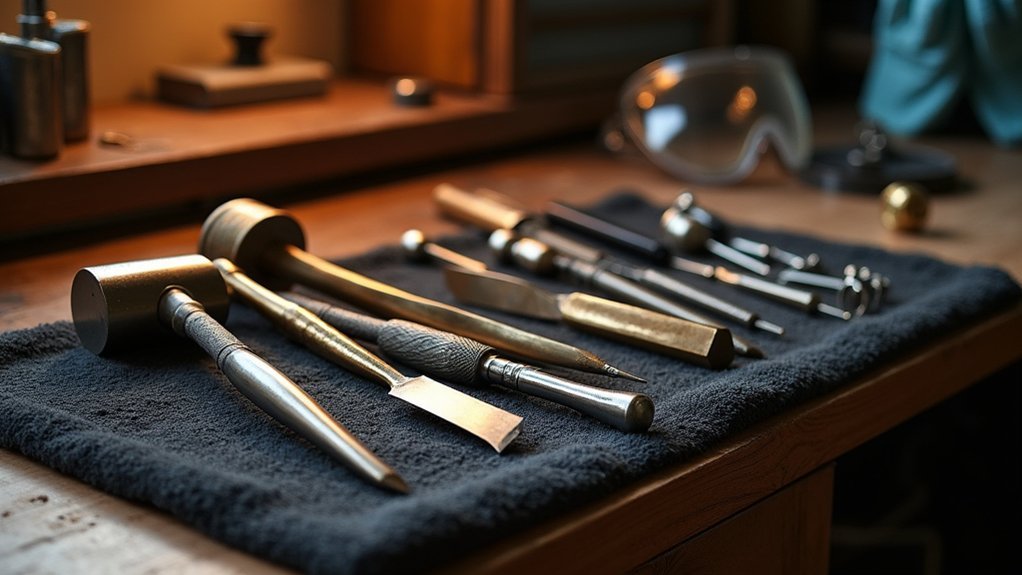
While assembling your thorough toolkit sets the foundation for successful metal chasing, creating a safe working environment protects both you and your jewelry pieces from potential hazards.
Always wear safety goggles to shield your eyes from metal shavings and flying debris when using chasing tools. Verify proper ventilation, especially when heating pitch, to prevent inhaling harmful fumes.
Protect your eyes with safety goggles and ensure adequate ventilation when heating pitch to avoid dangerous fumes during metal chasing work.
Wear an apron to protect your clothing and skin from hot materials and sharp edges. Maintain a clean, organized workspace to minimize accidents and keep tools accessible.
Practice proper posture by relaxing your shoulders and holding tools lightly for better control and reduced strain during extended chasing sessions.
Selecting the Right Chasing Tools for Beginners
Anyone entering the world of metal chasing should begin with a carefully selected basic toolkit rather than investing in expensive specialized equipment.
You’ll want to start with essential punches including liner, rounded, and flat-faced varieties that provide versatility for different design techniques.
When choosing your first tools, consider these key factors:
- Tool length – Select 3.5 to 4.5-inch tools, with shorter lengths offering better control for smaller hands
- Reputable brands – Consider affordable beginner sets from Mettle Works or Gene Olson for quality without breaking your budget
- Practice materials – Start with softer metals like copper for easier learning and less frustration
- Custom options – Learn to create tools from hardware store materials to deepen your understanding
This foundation will serve you well as your skills develop.
Step-by-Step Process for Creating Chased Designs
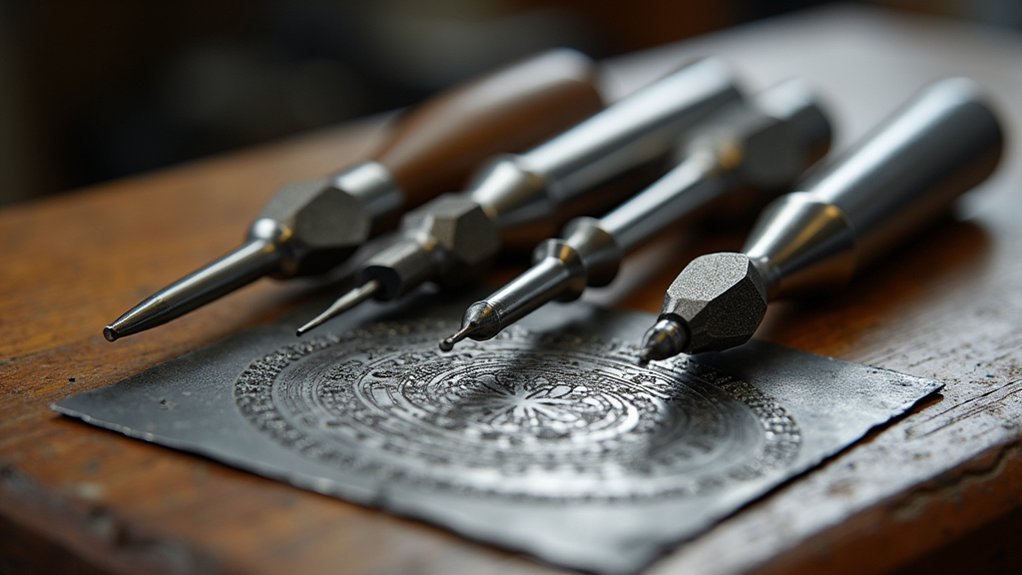
Once you’ve assembled your basic toolkit, creating your first chased design begins with careful planning and preparation. Start by drawing your design on paper, then transfer it onto copper sheet metal, which offers excellent workability for beginners learning chasing techniques.
| Step | Tool | Purpose |
|---|---|---|
| 1 | Tracer punch | Outline design gently |
| 2 | Straight/curved punches | Create depth and texture |
| 3 | Annealing torch | Maintain metal workability |
| 4 | Cleaning materials | Remove debris and oxidation |
Secure your metal in warm pitch to hold it steady during work. Use your tracer punch to outline the design, then employ straight or curved punches for depth. Remember to anneal regularly and clean the surface as needed. Return the metal to pitch repeatedly until your chased design reaches completion, embracing imperfections as artistic character.
Tool Maintenance and Hardening Techniques
Since your chasing tools represent a significant investment in both money and craftsmanship, maintaining them properly guarantees they’ll serve you for decades of jewelry making.
Tool maintenance begins with consistent cleaning to prevent rust and damage that compromises detailed work precision.
When hardening becomes necessary, heat your tools until they reach the proper color, then quench rapidly for desired hardness. Follow this essential sequence:
- Apply hand bar soap slurry during hardening to protect steel from scaling
- Monitor color changes carefully during the heating process
- Temper tools afterward by reheating slowly to reduce brittleness
- Inspect regularly for wear signs requiring timely repairs or replacement
Proper tempering guarantees even hardness distribution throughout each tool, preventing fractures during intensive chasing work while maintaining peak performance standards.
Choosing Appropriate Hammers and Mallets
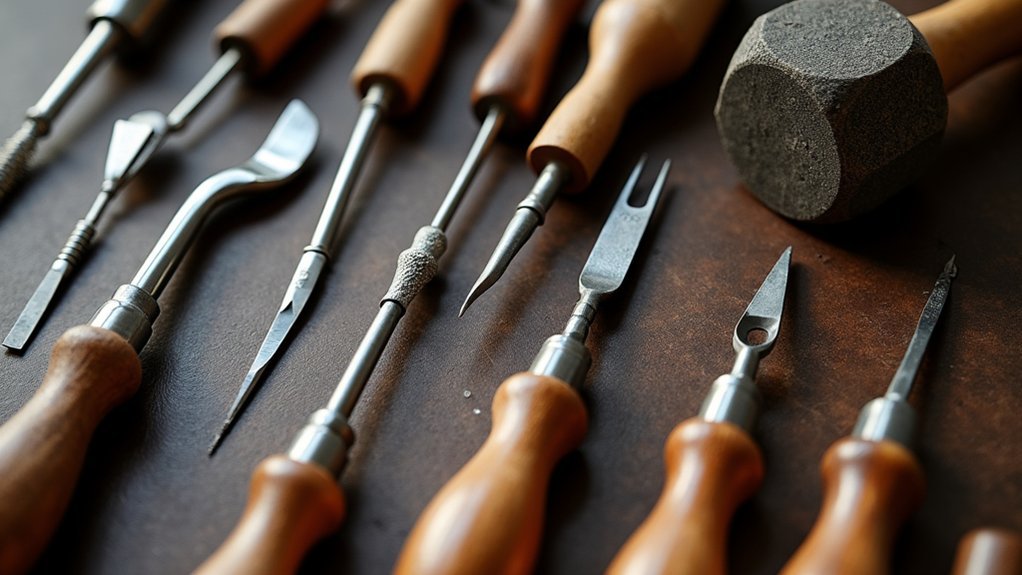
While your chasing tools shape the intricate details of your jewelry work, the hammers and mallets you select determine how effectively you’ll execute each technique.
Chasing hammers offer dual functionality with one flat face for striking tools and one round face for forming metal details. When shaping flat sheets into dimensional forms, you’ll need a raising hammer to strike the outside surface, followed by a planishing hammer to smooth and finish the worked metal.
For delicate operations, mallets made from rawhide or nylon won’t mar your precious metals since they feature identical faces.
The versatile ball-peen hammer excels at flattening, shaping, and driving chisels and punches, making it essential for general metalworking.
Choose your tools based on your specific task requirements.
Advanced Tips for Professional Results
Beyond selecting the right hammers and mallets, mastering specific techniques will elevate your chasing work from amateur to professional quality.
Professional jewelry making demands strategic tool selection and methodical execution to achieve refined results.
Control your punch depth by experimenting with different hammer weights and strike techniques. This balance between detail and volume creates sophisticated designs that distinguish professional work.
Mastering hammer weight and strike depth creates the sophisticated detail-to-volume balance that separates professional chasing from amateur work.
- Utilize liner, rounded, and doming punches strategically to create intricate textures and dimensional contrast
- Anneal your metal regularly throughout the process to maintain workability and achieve crisp, defined lines
- Maintain an organized workspace with clean tools for enhanced efficiency and uninterrupted creative flow
- Embrace imperfections as character-building elements that add uniqueness to your handcrafted jewelry pieces
Each deliberate hammer strike contributes to your piece’s distinctive personality and professional appeal.
Frequently Asked Questions
What Are Chasing Tools Used For?
You’ll use chasing tools to create detailed designs and textures on metal sheets by compressing material without removing any. They’ll help you define outlines, enhance volume perception, and imprint intricate patterns.
What Tools Do I Need for Metal Jewelry Making?
You’ll need chasing hammers with flat and rounded faces, various chasing punches for patterns, resin-based pitch to secure metal sheets, annealing torches for softening metal, and safety gear like goggles and aprons.
What Is Metal Chasing?
You’ll hammer metal’s surface using specialized tools to create raised designs and intricate patterns. This decorative technique lets you add detailed textures and artistic elements to jewelry pieces through precise, controlled strikes.
What Is the Difference Between Repousse and Chasing?
You’ll find repoussé stretches metal from behind to create raised forms, while chasing compresses from the front, adding surface details and textures. They’re opposite techniques that complement each other perfectly.
In Summary
You’ve now got the foundation to start your metal chasing journey. Remember, mastering these techniques takes practice, so don’t get discouraged if your first pieces aren’t perfect. Start with simple designs and gradually work your way up to more complex patterns. Keep your tools sharp, maintain proper workspace safety, and experiment with different hammer weights. With patience and dedication, you’ll develop the skills to create stunning chased jewelry pieces that showcase your artistic vision.

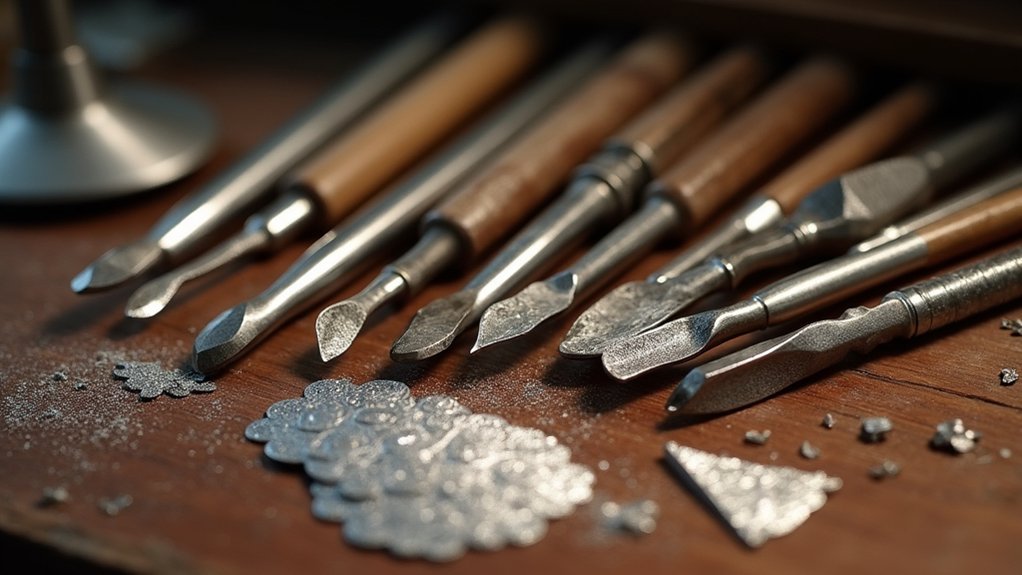

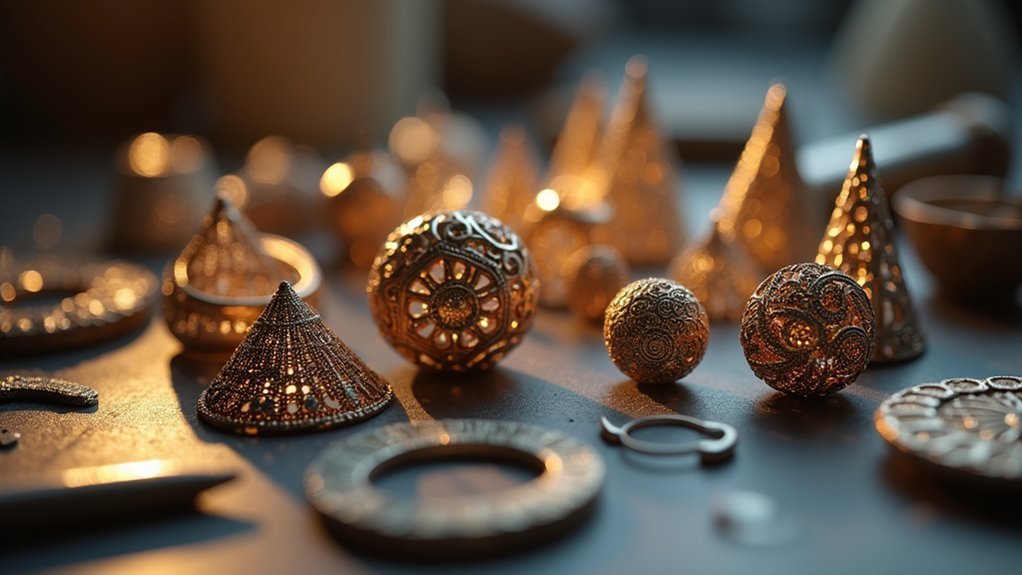

Leave a Reply